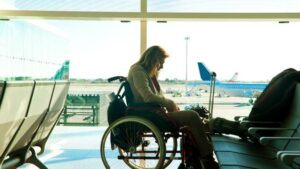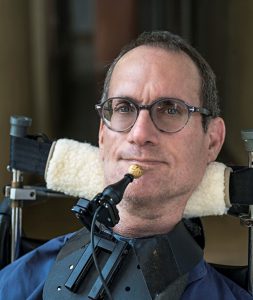Editor’s Note: Many people who use a wheelchair know that flying can be a nightmare. In an effort to make air travel more accessible, the U.S. Department of Transportation released the “Airline Passengers with Disabilities Bill of Rights” earlier this month. FacingDisability.com blogger, Ben Mattlin, reacts in the post below.
In July, the U.S. Department of Transportation (DoT) issued an “Airline Passengers with Disabilities Bill of Rights.” This sounded great! But a closer look revealed something else.
Disabled people have been brutalized by inaccessible airplanes since the Wright Brothers. We’re desperate for change. I, for one, would love to visit family across the country. But I just can’t hack flying anymore. This Bill of Rights could’ve meant something important. It could’ve meant a new freedom. Instead, it’s just the same old same old.

The ADA exempts airlines
Here’s the problem: When the Americans with Disability Act (ADA) was passed in 1990, it did not include the airlines. Maybe they had a good lobby. Their excuse, though, was that there was already a law on the books that said airlines can’t discriminate against disabled passengers: the Air Carrier Access Act of 1986 (ACAA).
Unfortunately, that older legislation is far less stringent than the ADA. It pretty much allows the airlines to do whatever they deem safe. And this so-called Bill of Rights does nothing to change that.
No “reasonable accommodations”
From the very first sentence, the new document plainly states that it’s only describing what is already covered. Sure, airlines can’t actually refuse service to disabled passengers. But there’s nothing about making reasonable accommodations, as the ADA requires for stores, restaurants, buses, trains, taxicabs, and most everything else.
Wheelchairs are treated like cargo
This means that, unlike in most other modes of public transit, wheelchair users must be lifted into a plane seat while their wheelchairs are stowed with the baggage and invariably returned damaged or in pieces, if they’re returned at all. (At last count, the DoT says that nearly 900 wheelchairs and scooters are damaged monthly.) Sometimes the consequences are fatal—such as in November 2021, when a Los Angeles–based disability advocate named Engracia Figueroa died from complications of injuries caused by an airline-damaged wheelchair.
Planes with 100 or more seats must try to fit “at least one normal-sized collapsible manual wheelchair” in an in-cabin storage space, the Bill of Rights reminds us. But if your chair doesn’t fit, it still has to go into the cargo hold.
If you have a motorized wheelchair, as I do, the airlines only have to accept it “if it fits in the cargo compartment and can be transported consistent with safety and security requirements.” So I can only fly on the biggest of planes—and even then, only after taking my chair apart so it’s deemed safe and so it fits.
Inaccessibly tight spaces
As the airlines try to squeeze every last penny out of passengers, they’re making no effort to provide more room for those who need extra space, as many disabled people do. Moreover, folks will have to continue limiting their beverage intake before flying, since the bathrooms remain impossible to maneuver in.
Granted, the Bill of Rights promises that airplanes “delivered after 1992” must have “at least one accessible lavatory, if the aircraft has more than one aisle,” as well as an onboard wheelchair to help you get to the lavatory. However, “accessible” is not defined in the way it is for public restrooms on land. And if you’re in a smaller or older plane, you just have to keep your legs crossed.
Service animals
The regulations regarding service animals are similarly narrow: Only specially trained dogs (such as guide dogs for blind people) can travel with passengers—unless airline personnel decide a dog is disruptive. Other service animals are not welcome.
Emotional support animals for people with chronic anxiety, panic attacks, depression, or other psychological disabilities may also be rejected or forced to travel in the baggage compartment—and their handlers may be charged extra fees—at the airline’s discretion.
Information is not accommodation
Yes, the document promises that airlines must provide information about airplane accessibility, if asked, in accessible formats, as well as assistance getting on and off planes “at most U.S. airports” and “except when boarding smaller aircraft (less than 19 seats).”
But information is not accommodation. And in any case, only big planes and big airports need to comply with even that.
How it should be
I long for the day I can roll into an airplane and stay in my wheelchair. The advocacy organization All Wheels Up has proved it’s safe. Plane seats only have to withstand impacts of 16 times the force of gravity, or 16 Gs, and the standard wheelchair tiedown can withstand 20 Gs.
So there really is no excuse. But instead of defending our rights, the DoT is defending the industry’s pigheadedness.
 Ben Mattlin is a Los Angeles-based freelance writer, author and frequent blogger for FacingDisability.com. He was born with spinal muscular atrophy, a congenital muscle weakness that causes paralysis and related health issues.
Ben Mattlin is a Los Angeles-based freelance writer, author and frequent blogger for FacingDisability.com. He was born with spinal muscular atrophy, a congenital muscle weakness that causes paralysis and related health issues.
Ben is the author of MIRACLE BOY GROWS UP: How the Disability Rights Revolution Saved My Sanity, and IN SICKNESS AND IN HEALTH: Love, Disability, and a Quest to Understand the Perils and Pleasures of Interabled Romance . He is a frequent contributor to the Washington Post, New York Times and Financial Advisor magazine. His work has also appeared in the Los Angeles Times, Chicago Tribune, and USA Today, and has been broadcast on NPR’s Morning Edition.
I am a wheelchair user and I have a service dog from Canine Companions. (canine.org) I’ve been lucky they haven’t destroyed my chair. The flight attendants are so enamored with Zeus that they stow my chair in a compartment in the galley.
Going through TSA is the worst! Several times I asked for a female agent to do the dreaded Pat down. I have been literally groped by several TSA agents to the point I wanted to report them. When I asked how do I do that, I was told it would take at least 30 minutes for a supervisor then another 45 minutes for paperwork and interview at a minimum. I would miss my flight each time if I did that. So I really wasn’t able to do that. That is truly upsetting. They definitely need more training especially sensitivity training when dealing with people like us.
I sit in the first row and Zeus lays at my feet. Passengers have no idea he is there until they deplane and see him.
Canine Companions has a great network. We share tips and tricks plus which airline is the best for us and our dogs.
I’ve become disabled in the past couple of years. I haven’t traveled on a plane since. I’m greatly mobility challenged. My brain and legs do not work together and I rely heavily on the use of a mobility scooter. I have no idea how I would travel via airplane. It just seems nearly impossible.
It’s shameful how the physically challenged are treated on airplanes. Their wheelchairs being stored in the cargo area and most of them damaged by individuals who mishandled the wheelchair ending in damage not even taken in account that their independence is taken away from them by not having their wheelchair available to them to use. Shame on the airlines for their thoughtless consideration to the rights and needs of the physically challenged individuals in wheelchairs. The ADA law never took into consideration of our rights on airplanes. Our government should do more to aid the physically challenged individuals. Shame on them